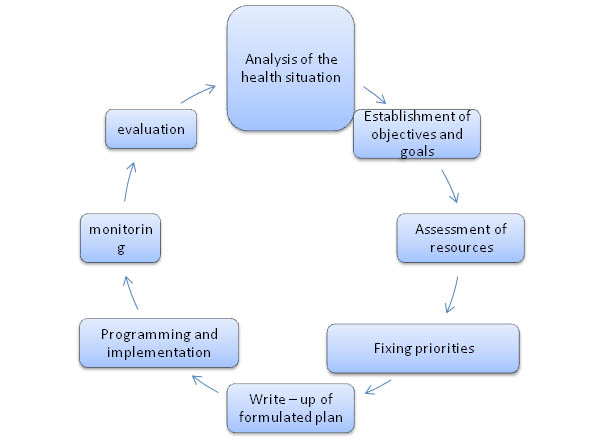
For lecture click: http://www.ihatepsm.com/resource/health-planning
Health Planning is defined as: The process of
- Analyzing the system for defining the problem
- Assessing the extent to which the problems exists as a need
- Formulating goals and objectives to alleviate the needs
- Assessment of resources
- Examining and choosing from alternative intervention strategies
- Initiating the necessary action for implementing the plan
- Monitoring the system to ensure proper implementation of the plan
- Evaluating the results of the intervention (% of the objectives achieved)
Health Planning Steps
• Analysis of the health situation
• Establishment of objectives and goals
• Assessment of resources
• Fixing priorities
• Write – up of formulated plan
• Programming and implementation
• Monitoring
• Evaluation
– Which reveals the new health situation i.e. AFTER the health program has been in place for some time
– And the planning cycle continues
Analysis of the situation
• The first step in health planning is the analysis of the current situation.
• The different aspects to be studied are:
– Population – age and sex structure, religion, SES etc.
– Morbidity and mortality rates
– Morbidity and mortality rates due to the disease under consideration
– Epidemiology and geographic distribution of the disease under consideration
– Existing healthcare facilities
– Technical manpower available
– Facilities for training healthcare staff
– Awareness and attitude of the community regarding the disease etc.
Establishment of objectives and goals
- This step is to identify the desirable future state for the issue under consideration .The program has to work for achieving this.
- Hence,goals and objectives , establish the standards against which current disease will be compared for assessing the performance of program
- if there are no clear objectives and goals, a plan cannot be implemented efficiently and haphazard wasteful activity will result.
- At the central level ,the objectives would be more general and with each successive level ,the objectives will become more specific.
- Management techniques are usually used to determine objectives ex : cost-benefit analysis
- These analysis will assess the feasibility of attaining the desired results in optimum cost and time
- the objective can be defined like: "To reduce the prevalence to the level of 0.5%"
Assessment of resources
- The available : Manpower,Money, Material,skills, knowledge and Techniques should be accessed
- A balance is to be struck between the available resources and the attainment of the objectives
Fix priorities
- The resources are usually not enough to attain all the objectives
- so priority goals should be listed out and resources should be allocated to these
- various considerations in fixing priorities can be :-
- in order of magnitude
- lower costs needed to achieve the objectives
- saving the lives of younger people
- political commitments and pressure etc
- Once the priority objectives have been decided:
- Alternative ways of achieving them should be assessed
- E.g. Whether vaccination is more cost effective or treatment of the cases? e.g. the disease itself may be mild and requiring inexpensive treatment whereas vaccine may need to be imported and very expensive for mass application. Hence a program for early diagnosis and treatment may be preferred over vaccination for achieving the target prevalence rate.
- Management techniques for comparing the efficiency of alternative plans may be useful for deciding priority
Write up formulated plan
- once priorities are laid out , a systematic plan should be made to attain them
- All the major steps should be included with the
- resources(input) required for each step
- the expected outcome(output) and
- time period specified for each step
- also include are
- precise guidelines for procedures
- Fixation of responsibility (identify individual responsible for the execution of each step)
Programming and implementation
- once the plan has been approved it has to be implemented
- Implementation requires an effective organization to run the routine procedures and referrals
- The real shortcomings or impracticalities of the program may be revealed at this stage
- Main consideration at this stage are
- definition of roles and tasks
- selection and training of personnel
- organization and communication so that all workers are aware of their responsibility and remain motivated
- the involved institutions should work efficiently
Monitoring
- Monitoring refers to the day to day follow up of functioning of program
- It is to be ensured that the activities are : proceeding as planned and are on schedule
- Immediate corrective action is to be taken in case of deviations
- Monitoring is thus defined as "the continuous process of observing ,recording and reporting on the activities of the organization or project
Evaluation
- Evaluation refers to the assessing the final outcome of the plan
- Evaluation is in terms of :
- Degree to which objectives are achieved
- How efficiently have the resources been utilized(output-input,cost-benefit analysis etc.) in achieving these
- What were the factors responsible for shortfalls
- Factors responsible for better performance if any
- Difficulties faced during the implementation of and possible solutions for them
- Based on the results of the evaluation, one of the following decisions may be taken:
- To continue running the program as the results are satisfactory
- To make a few changes to overcome inefficiencies and let the program continue
- To change the objectives as the disease profile has changed due to the effect of the program
- To abandon the approach and analyze alternative approaches
- The program failed to achieve the objectives or
- A new and much more effective technology has been developed for controlling the disease and needs to be incorporated in the program or
- A new and more dangerous health problem has emerged and the priority needs a change
For lecture click the link: http://www.ihatepsm.com/resource/health-planning
